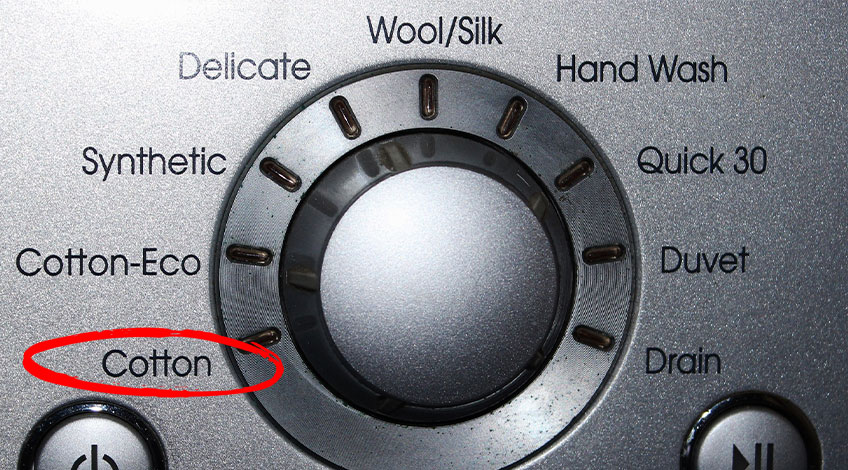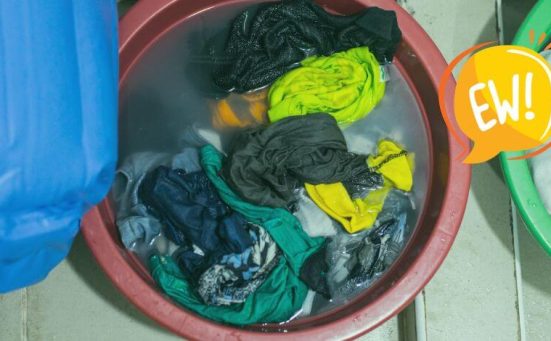
Quick Wash Vs Normal Washing Machine Cycle – What’s The Difference?
The short answer is that a quick wash cycle is a short, quick wash cycle that takes the least amount of time on a washing machine. But that’s only part of the story, to find out more, keep reading.
Washing machines have so many programmes, cycles and settings these days which makes it difficult to know which to use. In this article we look into the quick wash cycle and normal cycles and explain the differences.
What Is The Quick Wash Cycle On A Washing Machine?
The quick wash cycle is one of, if not the fastest cycles to be found on your washing machine. They do vary from appliance to appliance with the average duration of a quick wash being anywhere between 14 to 60 minutes.
The quick wash cycle has different names depending on the brand of washing machine you own. It is also known as the speed wash, the light wash or in some cases, an eco wash.
The majority of quick wash cycles are designed to wash only a small amount of laundry. Typically 1 to 2 kg whereas a full load is often 9 or 10 kg.
The quick wash is best suited for clothes that are not that dirty to begin with. It’s not a good idea to try to wash a full load or heavily soiled laundry using a quick wash.
The only way to successfully wash heavily soiled clothes using a quick wash is if those clothes were pre soaked for a few hours beforehand.
A quick wash cycle typically runs at 30 C which is a cool wash and unlikely to clean or sanitise heavily soiled clothes. It also has a limited spin cycle which can leave clothes feeling damper than usual.
Added to which the rinse isn’t as effective as the rinse on a normal wash cycle which could leave clothes with a soap residue.

What Are The Pros & Cons Of A Quick Wash Cycle?
Let’s look at the pros & cons now,
The Benefits Of A Quick Wash Cycle
The advantages of a quick wash cycle include;
- The ability to get clothes clean in a short time
- Great for sprucing up dusty clothes
- A time saving cycle
- Great for small wash loads
- Saves water by up to 30%
- Saves around 60% on electricity
The Disadvantages Of A Quick Wash Cycle
Disadvantages include;
- Limited load capacity
- Not effective on heavily soiled garments
- Insufficient spin cycle
- Inadequate rinse
When Is The Quick Wash Cycle The Right Cycle?
The quick wash cycle is great for;
- Washing clothes that aren’t too dirty
- Washing one or two items in a hurry
- Refreshing dusty items
- When you need a garment cleaned urgently
When Is The Quick Wash Cycle Not Suitable?
You should not use the quick wash cycle if;
- The clothes are filthy dirty
- You have a full load of laundry
- You need to wash greasy or oily work clothes
- You have delicate garments
- The garments need sanitising
- You prefer to wash items in hot water
As the quick wash is a short wash cycle it doesn’t cause too much damage to the material of your clothes which means they last longer.
It also helps to prevent mechanical breakdown of the appliance.
What Is A Normal Wash Cycle?
This is where things get interesting, or confusing depending on your point of view. Washing machines don’t have a normal cycle. Normal is whatever cycle you usually use.
For instance, in our household we mostly wear only 100% cotton clothes. Which means the normal cycle for us is the cotton cycle. You may wear mainly polyester clothes which would make your normal wash cycle the synthetics cycle.
Because everybody has a different preferred wash cycle, the normal wash cycles for the benefit of this article include;
- Cotton Cycle
- Wool Cycle
- Delicate Cycle
- Hand Wash Cycle
- Synthetics Cycle
- Selected Temperature Wash Cycles
Let’s look into these cycles in more detail
The Cotton Cycle

The cotton cycle typically uses water at 60 C which makes it one of the hottest cycles on most washing machines. As the name suggests, it’s used to clean cotton and other tough materials.
Due to the high heat, any germs or bacteria get destroyed quite quickly and the dirty items can get a deep clean. It is used mainly for;
- Cotton Clothes
- Cotton Underwear
- Socks
- Towels
- Bedding
A cotton wash cycle can take anywhere between one and three quarter hours to two and a half hours depending on your machine.
The Wool, Delicate & Hand Wash Cycles
All three of these cycles use low water temperatures to protect the materials from becoming damaged or shrinking.
They also operate with a lower spin speed too, to prevent damage as the drum turns and agitates the laundry.
These cycles are designed to wash;
- Woollens
- Silk
- Lingerie
- Delicates
These cycles typically run for around 45 to 60 minutes.
The Synthetic Cycle

The synthetic or easy care cycle is specifically designed for washing man made, synthetic fabrics. Synthetic cycles typically run at 40 C and have a reduced spin to prevent the fabrics from becoming damaged.
However, this lack of spin speed and less agitation can also prevent heavily soiled synthetic garments from getting properly cleaned.
Materials that this cycle is best suited for include;
- Polyester
- Nylon
- Elastane
- Lycra
- Spandex
- Acrylic
The synthetic cycle typically takes around the same time as the cotton cycle (2 to 2 ½ hours).
Selected Temperature Wash Cycles
These cycles allow you to choose the temperature the clothes are washed at. Temperatures typically range from cold (20 C or below) to 90 C. However it’s not often that the 90 C wash is ever needed or selected.
Higher temperatures work better for removing stains and sanitising clothes but you do run the risk of damaging the clothes if the water is too hot.
Lower temperature washes are often selected for lightly soiled clothes and full loads that only need to be freshened up.
What Is The Difference Between Quick Wash & Normal Wash?
With so many “normal” wash cycles to choose from, the main difference between a quick wash cycle and a normal wash cycle is diversity.
The so-called “normal” wash cycles are all designed for more specific fabrics. Whereas the quick wash is designed to be used as a fast way to wash relatively clean clothes and just refresh them.
That brings us to the next point, normal wash cycles have the ability to clean heavily soiled garments. Whereas the quick wash cycle can only really clean lightly soiled items.
Another major difference is the duration of the cycle, quick cycles are, well, quick! Whereas normal cycles can last for more than two hours.
What Are the Pros & Cons of A Normal Wash Cycle?
Let’s look at the pros & cons of using normal wash cycles on a washing machine.
The Benefits Of A Normal Wash Cycle
The main advantages of using a normal wash cycle include;
- The ability to wash a full load
- Wash cycles designed for specific fabrics
- A wide selection of programmes
- Can clean heavily soiled garments
- Specially designed cycles to give the correct care to the fabrics being washed
The Disadvantages Of A Normal Wash Cycle
The main disadvantages include;
- Long, slow run times
- Use more water
- Use more electricity
- Can cost more to run
- Confusing choices

When Should A Normal Wash Cycle Be Used?
You should use a normal wash cycle if you have lots of clothes of a similar fabric that all need to be washed. Or if you have heavily soiled garments or delicate materials.
Or any materials that would become damaged in a quick wash cycle like wool or silk.
How Long Are Normal Wash Cycles?
Normal wash cycles run for different times depending on the make and model of your washing machine. As a general rule;
- Synthetic cycles run for anywhere between 2 to 3 hours
- Cotton cycles run for around 1.5 to 4 hours
- Wool, delicate and hand wash cycles run for around 45 to 90 minutes
Which Wash Cycle Is Best: A Normal Wash Or A Quick Wash Cycle?
The answer to this question depends on the amount of laundry you have, how dirty it is and how quickly you need it washed. A normal wash is for more specific wash loads of similar fabrics which can be extremely dirty.
Whereas a quick wash cycle is for more general garments that are only slightly dirty and don’t need too much of a clean.
Normal wash cycles tend to run for far longer than quick wash cycles which means they’ll not only take longer to clean. They will also use more electricity and more water too.
So for small lightly soiled loads, the quick wash will be best. But for full loads of dirty clothes you will need a normal wash cycle specially suited for that particular fabric.
The reality is both normal and quick wash cycles have their place. And can both be used to do the laundry. It’s all about choosing the right cycle for a specific purpose.
Will A Quick Wash Get Clothes Clean?
A quick wash will get clothes clean as long as you use it correctly. That means only washing a few items that aren’t too dirty to begin with and using the correct amount of detergent to prevent leaving suds in the clothes when the cycle has finished.
The quick wash cycle won’t be effective if you overload the machine. Or you try to wash clothes that are really dirty, muddy, greasy or oily.
As with all things in life there are best practices that make using certain things better and as long as you stick to the best practices for using the quick wash cycle you will get great results.
SEE ALSO: Do Clothes Actually Get Clean On A Quick Wash?
SEE ALSO: LG Washing Machine Cycles Explained (front & top load settings)
Frequently Asked Questions
The quick wash is different to a normal wash because: it has a far shorter duration, is only suitable for a few items of clothing at a time, can only successfully clean lightly soiled washing and is not suitable for delicate items.
The quick wash cycle will clean your clothes as long as you don’t put too many clothes in the drum, the clothes are not heavily soiled and don’t need to be sanitised.
As a quick wash cycle has a short spin time and runs using cold water, it uses up to 60% less electricity than a normal wash cycle.
Also, follow us on Pinterest ...



